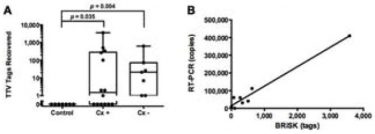Although rare, infectious endophthalmitis is among the most serious post-surgical complications of ophthalmic surgery because it can result in serious vision loss. The standard technique for diagnosing endophthalmitis is microbial culture, but this technique fails to identify an organism in many cases. 16S polymerase chain reaction is more sensitive and specific than traditional culture techniques, but is limited to bacteria and cannot detect fungi (which require separate fungal rDNA ribosomal PCR), parasites, or viruses. Biome Representational in Silico Karyotyping (BRiSK) is a newer technique used to purify a defined fraction of all DNA present in a sample and sequence it to near saturation, allowing for the identification of most known bacteria, as well as phage, viruses, and previously unknown organisms. In this study, the authors applied this deep DNA sequencing technique to vitreous and aqueous biopsies from patients with endophthalmitis to test the hypothesis that uncultured organisms may be present in cases of culture-negative endophthalmitis.
The authors tested 28 eyes undergoing routine vitreous surgery, including seven control eyes. None of the controls yielded positive results for bacteria or virus by culture or 16S polymerase chain reaction. Fourteen of the 21 remaining samples (66.7%) from eyes harboring suspected infectious endophthalmitis were culture-positive, with Staphylococcal and Streptococcal species as the most common organisms.

Interestingly, the BRiSK results demonstrated that 57.1% of the culture-positive samples and 100% of culture-negative samples were positive for torque teno virus sequences. None of the controls had this finding. Presence of Torque Teno Virus DNA was confirmed in seven cases by qPCR.
Although the sample size in this study was small, the results suggests that culture-negative cases of presumed infectious endophthalmitis are indeed largely devoid of abundant fastidious or novel bacteria. The unexpected presence of torque teno virus in the vitreous of patients with endophthalmitis generates many further research questions. The current study cannot distinguish whether torque teno virus is a direct intraocular pathogen, an adjuvant for inflammation, a general marker of inflammation, or a commensal virus, but the identification of the virus provides a testable hypothesis for a pathogenic mechanism in culture-negative endophthalmitis.
Lee AY, Akileswaran L, Tibbetts MD, Garg SJ, Van Gelder RN. Identification of torque teno virus in culture-negative endophthalmitis by representational deep DNA sequencing. Ophthalmology. 2015 Mar;122(3):524-30. doi: 10.1016/j.ophtha.2014.09.001. Epub 2014 Nov 24. PubMed PMID: 25439613; PubMed Central PMCID: PMC4339625.

